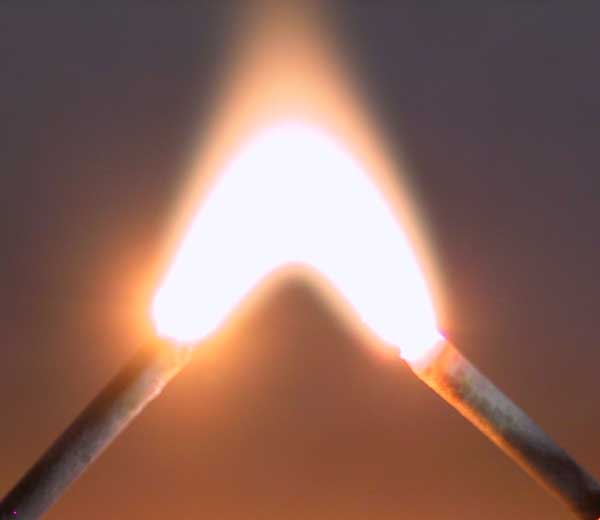|
Arc Mapping
Arc mapping is a technique used in fire investigation that relies on finding the locations of electrical arcs and other electrical faults that occurred during a fire; the locations of the electrical faults can then, under some circumstances, indicate the progression of the fire over time. It is usually performed by a forensic electrical engineer. It The technique relies on the assumption that, when heat from fire (or from hot gases caused by the fire) impinges on an electrical line (whether or not protected by a conduit), it will melt the wire insulation and cause an electrical fault at the first point that it reaches on the electrical line. For this to occur, the electrical line must be energized at the time that fire hits it. Origin of fire Arc mapping often aims to determine the point of origin of the fire. A common assumption used in reaching this goal is that the fire expands uniformly in all directions as it burns, and maintains a circular shape centered on the point o ... [...More Info...] [...Related Items...] OR: [Wikipedia] [Google] [Baidu] |
Fire Investigation
Fire investigation, sometimes referred to as origin and cause investigation, is the analysis of fire-related incidents. After firefighters extinguish a fire, an investigation is launched to determine the origin and cause of the fire or explosion. Investigations of such incidents require a systematic approach and knowledge of basic fire science. Investigating fires The difficulty of determining whether arson has occurred arises because fire often destroys the key evidence of its origin. Many fires are caused by defective equipment, such as shorting of faulty electrical circuits. Car fires can be caused by faulty fuel lines, and spontaneous combustion is possible where organic wastes are stored. A fire investigator looks at the fire remains, and obtains information to reconstruct the sequence of events leading up to the fire. One of the challenging aspects of fire investigation is the multi-disciplinary basis of the investigator's job. As fires can be caused by or involve many ... [...More Info...] [...Related Items...] OR: [Wikipedia] [Google] [Baidu] |
Electric Arc
An electric arc, or arc discharge, is an electrical breakdown of a gas that produces a prolonged electrical discharge. The electric current, current through a normally Electrical conductance, nonconductive medium such as air produces a plasma (physics), plasma; the plasma may produce visible light. An arc discharge is characterized by a lower voltage than a glow discharge and relies on thermionic emission of electrons from the electrodes supporting the arc. An archaic term is voltaic arc, as used in the phrase "voltaic arc lamp". Techniques for arc suppression can be used to reduce the duration or likelihood of arc formation. In the late 19th century, Arc lamp, electric arc lighting was in wide use for Street light#Arc lamps, public lighting. Some low-pressure electric arcs are used in many applications. For example, fluorescent lamp, fluorescent tubes, mercury, sodium, and metal-halide lamps are used for lighting; xenon arc lamps have been used for movie projectors. Electric a ... [...More Info...] [...Related Items...] OR: [Wikipedia] [Google] [Baidu] |
Electrical Faults
In an electric power system, a fault or fault current is any abnormal electric current. For example, a short circuit is a fault in which a live wire touches a neutral or ground wire. An open-circuit fault occurs if a circuit is interrupted by a failure of a current-carrying wire (phase or neutral) or a blown fuse or circuit breaker. In three-phase systems, a fault may involve one or more phases and ground, or may occur only between phases. In a "ground fault" or "earth fault", current flows into the earth. The prospective short-circuit current of a predictable fault can be calculated for most situations. In power systems, protective devices can detect fault conditions and operate circuit breakers and other devices to limit the loss of service due to a failure. In a polyphase system, a fault may affect all phases equally, which is a "symmetric fault". If only some phases are affected, the resulting "asymmetric fault" becomes more complicated to analyse. The analysis of these types ... [...More Info...] [...Related Items...] OR: [Wikipedia] [Google] [Baidu] |
Forensic Engineering
Forensic engineering has been defined as ''"the investigation of failures - ranging from serviceability to catastrophic - which may lead to legal activity, including both civil and criminal".'' It includes the investigation of materials, products, structures or components that fail or do not operate or function as intended, causing personal injury, damage to property or economic loss. The consequences of failure may give rise to action under either criminal or civil law including but not limited to health and safety legislation, the laws of contract and/or product liability and the laws of tort. The field also deals with retracing processes and procedures leading to accidents in operation of vehicles or machinery. Generally, the purpose of a forensic engineering investigation is to locate cause or causes of failure with a view to improve performance or life of a component, or to assist a court in determining the facts of an accident. It can also involve investigation of intel ... [...More Info...] [...Related Items...] OR: [Wikipedia] [Google] [Baidu] |
Electrical Engineering
Electrical engineering is an engineering discipline concerned with the study, design, and application of equipment, devices, and systems which use electricity, electronics, and electromagnetism. It emerged as an identifiable occupation in the latter half of the 19th century after commercialization of the electric telegraph, the telephone, and electrical power generation, distribution, and use. Electrical engineering is now divided into a wide range of different fields, including computer engineering, systems engineering, power engineering, telecommunications, radio-frequency engineering, signal processing, instrumentation, photovoltaic cells, electronics, and optics and photonics. Many of these disciplines overlap with other engineering branches, spanning a huge number of specializations including hardware engineering, power electronics, electromagnetics and waves, microwave engineering, nanotechnology, electrochemistry, renewable energies, mechatronics/control, and electrical m ... [...More Info...] [...Related Items...] OR: [Wikipedia] [Google] [Baidu] |
Fuel Loads
A fuel is any material that can be made to react with other substances so that it releases energy as thermal energy or to be used for work. The concept was originally applied solely to those materials capable of releasing chemical energy but has since also been applied to other sources of heat energy, such as nuclear energy (via nuclear fission and nuclear fusion). The heat energy released by reactions of fuels can be converted into mechanical energy via a heat engine. Other times, the heat itself is valued for warmth, cooking, or industrial processes, as well as the illumination that accompanies combustion. Fuels are also used in the cells of organisms in a process known as cellular respiration, where organic molecules are oxidized to release usable energy. Hydrocarbons and related organic molecules are by far the most common source of fuel used by humans, but other substances, including radioactive metals, are also utilized. Fuels are contrasted with other substances or dev ... [...More Info...] [...Related Items...] OR: [Wikipedia] [Google] [Baidu] |
Circuit Breaker
A circuit breaker is an electrical safety device designed to protect an electrical circuit from damage caused by an overcurrent or short circuit. Its basic function is to interrupt current flow to protect equipment and to prevent the risk of fire. Unlike a fuse, which operates once and then must be replaced, a circuit breaker can be reset (either manually or automatically) to resume normal operation. Circuit breakers are made in varying sizes, from small devices that protect low-current circuits or individual household appliances, to large switchgear designed to protect high voltage circuits feeding an entire city. The generic function of a circuit breaker, or fuse, as an automatic means of removing power from a faulty system, is often abbreviated as OCPD (Over Current Protection Device). Origins An early form of circuit breaker was described by Thomas Edison in an 1879 patent application, although his commercial power distribution system used fuses. Its purpose was ... [...More Info...] [...Related Items...] OR: [Wikipedia] [Google] [Baidu] |
Ground And Neutral
Ground and neutral are circuit conductors used in alternating current electrical systems. The ground circuit is connected to earth, and neutral circuit is usually connected to ground. As the neutral point of an electrical supply system is often connected to earth ground, ground and neutral are closely related. Under certain conditions, a conductor used to connect to a system neutral is also used for grounding (earthing) of equipment and structures. Current carried on a grounding conductor can result in objectionable or dangerous voltages appearing on equipment enclosures, so the installation of grounding conductors and neutral conductors is carefully defined in electrical regulations. Where a neutral conductor is used also to connect equipment enclosures to earth, care must be taken that the neutral conductor never rises to a high voltage with respect to local ground. Definitions Ground or earth in a mains ( AC power) electrical wiring system is a conductor that provides a lo ... [...More Info...] [...Related Items...] OR: [Wikipedia] [Google] [Baidu] |
NFPA 921
NFPA 921, "Guide for Fire and Explosion Investigations", is a peer reviewed document that is published by the National Fire Protection Association (NFPA). Its purpose is "to establish guidelines and recommendations for the safe and systematic investigation or analysis of fire and explosion incidents" (section 1.2.1). Familiarity with NFPA 921 is strongly recommended by National Association of Fire Investigators and the International Association of Arson Investigators (IAAI). NFPA 921 forms a large basis of the information which a professional fire investigator must know to pass the various Fire Investigator Certification (NAFI and IAAI) examinations. While not every recommendation in NFPA 921 will apply to any particular fire or explosion investigation, the document itself recommends that if a particular fire investigator does not apply certain sections to an investigation where they are called-for, the investigator must be prepared to justify the exclusion. This standard was l ... [...More Info...] [...Related Items...] OR: [Wikipedia] [Google] [Baidu] |
Kirk's Fire Investigation
''Kirk's Fire Investigation'' by David J. Icove and Gerald A. Haynes has long been regarded as the primary textbook in the field of fire investigation.J.F. Decker and B.L. Ottley, Arson Law and Prosecution, Carolina Academic Press, , 2009, p. 22. It is currently in its 8th edition (published in 2017, ). The book is now in close accordance to the 2017 Edition of NFPA 921, Guide for Fire and Explosion Investigation; the 2014 Edition of NFPA 1033, Standard for Professional Guidelines for Fire Investigators; and the model curriculum of the Fire Emergency Service Higher Education (FESHE) group. The title refers to Paul Leland Kirk Paul Leland Kirk (May 9, 1902 – June 5, 1970) was a biochemist, criminalist and participant in the Manhattan Project who was specialized in microscopy. He also investigated the bedroom in which Sam Sheppard supposedly murdered his wife and ... (1902-1970), the author of the original text ''Fire Investigation'' that was the basis for ''Kirk's Fi ... [...More Info...] [...Related Items...] OR: [Wikipedia] [Google] [Baidu] |
Fire
Fire is the rapid oxidation of a material (the fuel) in the exothermic chemical process of combustion, releasing heat, light, and various reaction Product (chemistry), products. At a certain point in the combustion reaction, called the ignition point, flames are produced. The ''flame'' is the visible portion of the fire. Flames consist primarily of carbon dioxide, water vapor, oxygen and nitrogen. If hot enough, the gases may become ionized to produce Plasma (physics), plasma. Depending on the substances alight, and any impurities outside, the color of the flame and the fire's Intensity (heat transfer), intensity will be different. Fire in its most common form can result in conflagration, which has the potential to cause physical damage through burning. Fire is an important process that affects ecological systems around the globe. The positive effects of fire include stimulating growth and maintaining various ecological systems. Its negative effects include hazard to life and pr ... [...More Info...] [...Related Items...] OR: [Wikipedia] [Google] [Baidu] |



